
If you’ve read me long, you’ve heard it before – no matter how good the textbook is, at least in my experience, it’s never motivated students past September, and it’s out of date as soon as it’s printed. Of course there are lots of other arguments – artificial order, ridiculously expensive supplements, faulty companion assessments, lack of authentic materials, and so on. After you’ve read a research-based book, found a way to collaborate, and surveyed your students, my fourth idea for a 2014 resolution is to
4. Take a step outside the textbook.
Breaking from the textbook is a hard, daunting task. Really, it took me about three school years to completely kick the textbook out of my classroom. So I’ve blogged several times about ways to step outside your textbook, including a three-part series on easing into developing your own curriculum. Here are a few quick, easy ideas to find a motivating, effective, proficiency-based activity you can do, textbook-free.
- Play a song. In true Musicuentos style, this is my #1 tip. Pick something in a genre at least some of your students like (Latinoamérica?), something catchy (Niña Bonita?), something relevant to life and language (Voy a vivir?). Use it to get your students singing (Aserejé?), talking about culture (why the reference to Sammy Sosa in La llave de mi corazón? why the little ball players in the video?), exploring a grammatical form (reflexives in Hace Tiempo?), or looking at vocabulary (nature in En medio de la tempestad?). Far and away the best resource to help you find the right song for whatever vocabulary, country, or grammar concept you’re looking for is Sharon Birch’s music database. The next best is, of course, Zachary Jones’s Panorama Temático and Panorama Gramático.
- Tell a story. It’s Musicuentos, after all, so this is my #2 tip. I won’t go into it much here because I’ve already written a popular post on supplementing your curriculum with storytelling. Also check out seven keys to a great story.
- Explore Google Earth. Get students describing places, touring museums, following story characters, and so on. Anytime your textbook addresses a place, break out Google Earth and explore that place. Or pair it with #1 and use it to do more with a song.
- Have students survey each other and report results. What are you working on – home life? Activities? Get students talking to find out what their classmates’ homes, or school schedules, or meal preferences are, and report results. Get some math in there and why not do percentages?
- Speaking of math, incorporate some cross-curricular content. Find out what your students are studying in another class and plan some way to connect it with your content.
- Get students out of the classroom. It doesn’t have to be quite so involved as an off-campus field trip: send them on a scavenger hunt- better yet, a photo or video scavenger hunt. Work on following directions and develop a map. Work on describing places and people and visit school offices and their personnel.
What other suggestions do you have for how to get outside the textbook?
2 Comments
Comments are closed.



I am way behind in my blog reading and Twitter/facebook world, so I just now got a chance to catch up with your blog! Thank you so much for including me in this post. I can’t believe that I would be here, with you and with Zachary Jones! I get so much inspiration and so many resources from both of you! Thank you for everything that you do to promote the successful acquisition of language!
Meeting you is on my bucket list, Sharon. 😉